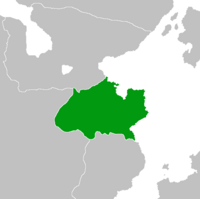Pozolanni: Difference between revisions
No edit summary |
No edit summary |
||
| Line 109: | Line 109: | ||
|DST_note = <!--Optional note regarding DST use--> | |DST_note = <!--Optional note regarding DST use--> | ||
|antipodes = <!--Place/s exactly on the opposite side of the world to country/territory--> | |antipodes = <!--Place/s exactly on the opposite side of the world to country/territory--> | ||
|date_format = | |date_format = yyyy/mm/dd/ | ||
|drives_on = right | |drives_on = right | ||
|cctld = .pz | |cctld = .pz | ||
Revision as of 16:44, 27 June 2022
This article is incomplete because it is pending further input from participants, or it is a work-in-progress by one author. Please comment on this article's talk page to share your input, comments and questions. Note: To contribute to this article, you may need to seek help from the author(s) of this page. |
Kingdom of Pozolanni Reine de Pessulaña (Pozolanni) | |
|---|---|
| Motto: Nada es ederra sin mina. "Nothing is beautiful without struggle." | |
| Anthem: | |
 Location of Pozolanni (dark green) | |
| Capital | Acheuli |
| Largest | Atiberan |
| Official languages | Pozolanni |
| Recognised national languages | Vivanquian ∙ Mercanti |
| Ethnic groups (2020) | Pozolanni 73.2% Vivanquian 22.4% Hariáli 3.4% Others 1.2% |
| Religion (2020) | Kérygism 41.2% Vestrisism 23.5% Courantism 18.9% Aerzeanism 8.4% Others 8.0% |
| Demonym(s) | Pozolanni |
| Government | Unitary presidential constitutional monarchy |
• Monarch | Carlito II |
• Lehendakari | Emigdio Tejeda |
| Legislature | Pozolanni Legislative Assembly |
| Formation | |
• Independence from Rethan | 1092 |
• Acutanian Restoration | 1701 |
• Pozolanni Kingdom | 1872 |
• Current constitution | 1969 |
| Area | |
• Total land area | 101,768 km2 (39,293 sq mi) |
| Population | |
• 2020 estimate | 10,095,385 |
• Density | 99.4/km2 (257.4/sq mi) |
| GDP (PPP) | 597.9 billion IBU estimate |
• Per capita | 59,229 IBU |
| GDP (nominal) | estimate |
• Per capita | 51,568 IBU |
| Gini | 28.3 low |
| HDI | 0.882 very high |
| Currency | Pozolanni Lira (ɫ) (PZL) |
| Date format | yyyy/mm/dd/ |
| Driving side | right |
| Calling code | +27 |
| Internet TLD | .pz |
Pozolanni (Pozolanni: Pessulaña [pɛtˈtswːleɪɲə]), officially the Kingdom of Pozolanni (Reine de Pessulaña), is a country situated in Central Meterra. It borders Vivanco to the north and Pacronesia to the south; while Demescia lies to the west across the sea. Pozolanni is home to roughly ten million people and it covers an area of 101,768 square kilometers (39,293 sq mi). The official language of the country is Pozolanni, which is split between multiple different dialects, while Vivanquian and Mercanti are also formally recognized. Acheuli is the country's capital, while Atiberan is the largest city. Both cities are located on the Pozolanni coastline, where nearly three-quarters of the population resides.
Generally, archeologists and historians agree that the first humans arrived in modern-day Pozolanni between 40,000 to 30,000 years ago during the last ice age. The first permanently-settled agricultural communities are believed to have developed about 10,000 years ago within the Moraga Valley, being some of the oldest known villages in Meterra. By 6000 BC, the rise of permanent settlements allowed for the development of the Moragan city-states within the region, incentivizing further technological and cultural growth. Further growth of the Moragan city-states lead to the formation of empires such as Lur, Rumia, and Beran. In 3000 BC, the maritime-based Serrennican culture would arise in the east, establishing vast trade networks across the Meterran Sea. The Moraga Valley and Erekosta were conquered in XXXX by Rethan, later being incorporated into the Kingdom of Rethan.
During the Rethan Civil War in 1000 AD, Moraga and Erekosta broke away, declaring the Acutanian Kingdom. Following the War of Acutanian Succession in 16XX, Acutania entered into a dynastic union with Vivanco, ending in 16XX/17XX. By the 19th century, Pozolanni nationalism began to take hold, along with growing opposition to Vivanquian influence. The Pozolanni Kingdom was proclaimed in 1872, following the annexation of the Principality of Serrenno. The nascent Pozolanni Kingdom swiftly modernized during this time period, developing a robust shipping industry and strong trade relations. Oil reserves would be discovered in 1896 along the Irrisari coast, with later exploration in 1920 uncovering more reserves in Serrenno. The growth of the Pozolanni oil industry fueled further economic growth, with the industry becoming the country's number one export for many years. During the Fascist Wars, Pozolanni initially remained neutral, though it late cut off economic ties with the Dominion and helped supply the Allies with fuel, food, and weaponry. Following the end of the Fascist Wars, the Pozolanni economy would enter into a period of recession as a result of the collapse of oil prices and a reduction in export demands. The ensuing economic turmoil allowed for the rise of a socialist dictatorship in 1954. However, by 1968, popular discontent with the ruling regime had hit a breaking point, and democracy would be restored following the Lilac Revolution. In the 1980s, Pozolanni enjoyed a prolonged economic boom fueled by increased oil production and a greater shift towards economic modernization and development.
Etymology
Pozolanni --> Pessulaña
History
history
Prehistory and antiquity
Archaic and Classical period
Kérygist Era
Rethanist Era
Early Modern Era
Modern Period
Unification
Kingdom of Pozolanni
Fascist Wars
Gustavoist dictatorship
Democratic restoration
Recent History
Geography
geography

